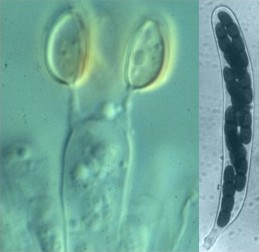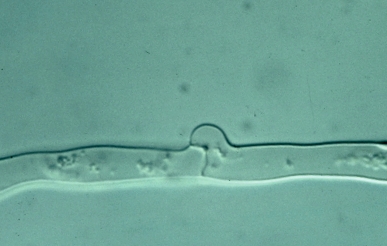DISCUSSION OF THE DIKARYA

The Dikarya embrace two great phyla, the Ascomycota and the Basidiomycota, accounting for the vast majority of fungi. The obvious difference between these two groups is the way that they produce their spores following meiosis, depicted in the picture at left. The Basidiomycota produce their meiospores, called basidiospores, externally on basidia (leftmost of the two panels), while the Ascomycota produce theirs, called ascospores, in asci (right panel). To learn more about these structures and how they produce their spores read the section on asci and basidia. The picture at left does not do justice to the variety of these structures. Basidia can be round or elongated, 1-spores to 8-spored, septate or nonseptate. Asci can be round to elongated and contain a single spore or more than a thousand. Ascospores can range from single-celled to many-celled. In general we can say that basidia are most commonly 4-spored and asci 8-spored, and that basidiospores are almost always single-celled. One invariable fact is that basidiospores are always borne externally on the basidium and ascospores are always borne internally in the ascus.
There are other less obvious differences between the Asco- and Basidiomycota. Of course as members of the Dikarya both groups spend part of their lives in a dikaryotic state, one in which their cells contain two genetically different nuclei that divide together so that the daughter nucleus of each one moves into the new cell.
The animation above shows a dikaryotic hypha growing and dividing. Notice that the division of the nuclei appears to go backward and how the little buckles, called clamp connections pass a nucleus back over the developing septum.
 Clamp connections probably occur throughout the Dikarya but are most readily seen in the Basidiomycota. If you can see clamp connections you are most certainly looking at one of the Basidiomycota. The fact that clamp connections are rarely seen in the Ascomycota probably indicates that most species, in common with many Basidiomycota, carry out nuclear division without the use of these structures. However, ascomycetes often produce croziers, structures similar to clamp connections in both form and function.
Clamp connections probably occur throughout the Dikarya but are most readily seen in the Basidiomycota. If you can see clamp connections you are most certainly looking at one of the Basidiomycota. The fact that clamp connections are rarely seen in the Ascomycota probably indicates that most species, in common with many Basidiomycota, carry out nuclear division without the use of these structures. However, ascomycetes often produce croziers, structures similar to clamp connections in both form and function.
There is another compelling reason why we don't see clamp connections in the Ascomycota. In the life cycle of most Basidiomycota the dikaryotic state becomes established quite soon after the first hyphae begin to grow. Among growing hyphae many are sexually compatible and pass nuclei to one another, establishing a dikaryon in the process. The resulting dikaryotic hyphae then carry on growing, leading to a large and entirely dikaryotic colony. In the Ascomycota the dikaryon becomes established in specialized cells called ascogonia which then give rise to small dikaryotic systems that are soon converted via meiosis to asci and ascospores. The dikaryotic systems, and their potential clamp connections, are just too limited and too short-lived to be observed easily. So here we have a second fundamental difference between the Ascomycota and the Basidiomycota:
-
The Ascomycota have small and usually short-lived dikaryotic states that are dependent upon the monokaryotic state
-
The Basidiomycota have large and usually long-live dikaryotic states that are not dependent on the monokaryotic state